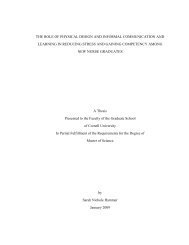The Patient Room: what is the ideal solution? - Cornell University
The Patient Room: what is the ideal solution? - Cornell University
The Patient Room: what is the ideal solution? - Cornell University
You also want an ePaper? Increase the reach of your titles
YUMPU automatically turns print PDFs into web optimized ePapers that Google loves.
Single <strong>Patient</strong> <strong>Room</strong> and Layout Complications<br />
Building a hospital with a majority of single-patient rooms changes <strong>the</strong> layout of <strong>the</strong> hospital floor. Typically, th<strong>is</strong><br />
construction leng<strong>the</strong>ns <strong>the</strong> corridors of hospital wards and <strong>the</strong>refore increases walking d<strong>is</strong>tances for staff<br />
members-- primarily <strong>the</strong> nursing staff. Th<strong>is</strong> in turn could result in nurse fatigue and frustration, and <strong>the</strong>refore<br />
lower quality of patient care.<br />
A tendency for hospitals, when building 100% single -<br />
patient rooms, <strong>is</strong> to align each room one after <strong>the</strong> o<strong>the</strong>r,<br />
creating long corridors for <strong>the</strong> nurses to travel. Th<strong>is</strong><br />
alignment <strong>is</strong> often necessary to ensure that each private<br />
room maintains its privacy and that each one’s layout <strong>is</strong><br />
identical to <strong>the</strong> next (<strong>the</strong> “handedness” of <strong>the</strong> room). <strong>The</strong><br />
identical nature of each room allows for greater staff<br />
efficiency and safety because all of <strong>the</strong> supplies and<br />
facilities kept within <strong>the</strong> room can be found quickly and<br />
easily. <strong>The</strong> long corridors that are oftentimes inevitable,<br />
however, increase <strong>the</strong> d<strong>is</strong>tances traveled by nurses<br />
daily, which can ultimately lead to nurse fatigue given<br />
<strong>the</strong>ir long hours. According to John Reiling, President<br />
and CEO of Synergy Health and St. Joseph’s Hospital,<br />
“Fatigue has been identified as a contributing factor to<br />
human error. While <strong>the</strong> effects of fatigue on patient<br />
safety <strong>is</strong> not known, fatigue has been found to have a<br />
negative impact on alertness, mood, and<br />
psychomotor and cognitive performance, which can<br />
have an impact on patient safety” ( Hughes, 2008). 40







